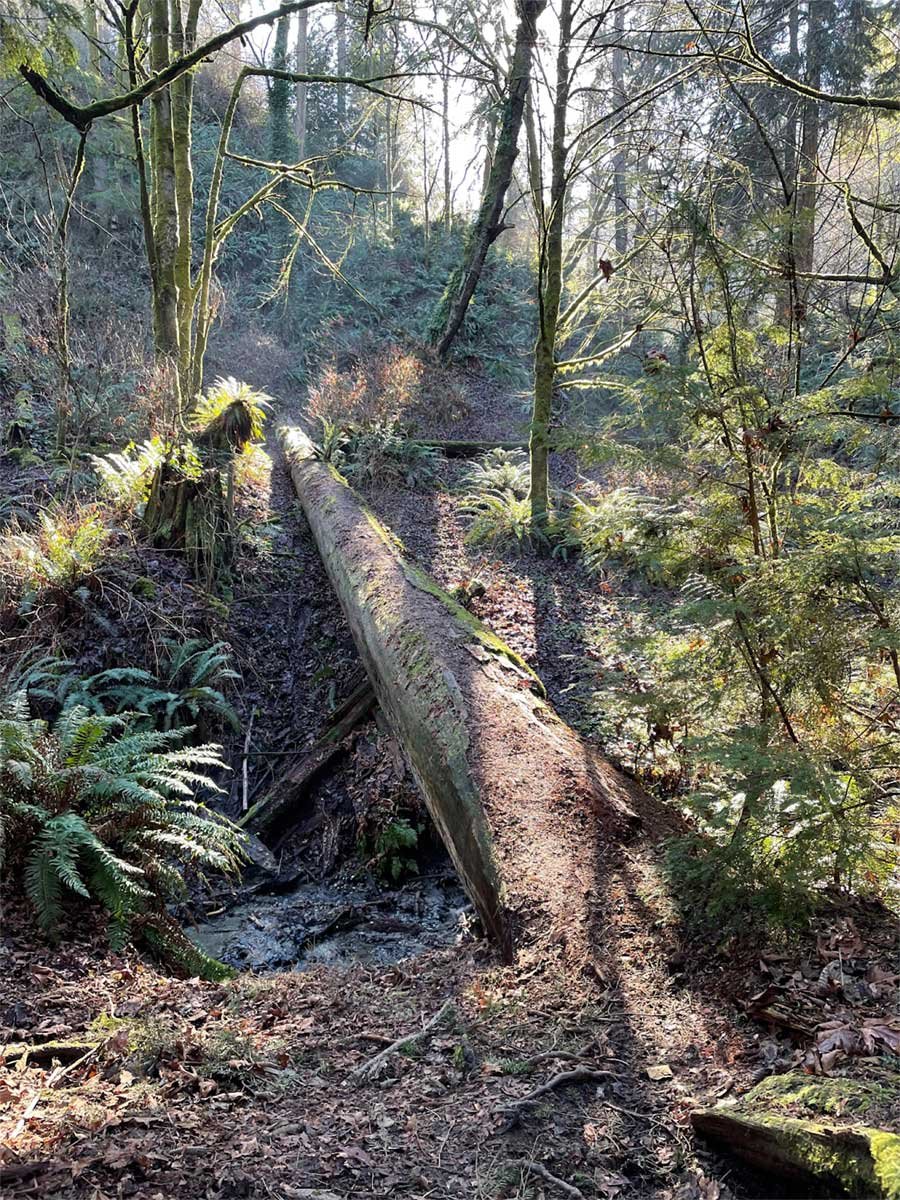Student Associate investigates soil health in Seattle
GNGS Associate Dira Mahmud tests the Schmitz Preserve
Pictured here, a trail to one test site.
By Guest Author Dira Mahmud
Dira Mahmud is a current GNGS Student Associate and senior at Middlebury College studying Earth & Climate Sciences. On campus, she is part of the ECSC Department Student Advisory Board, a Climate Action Fellow, as well as a coxswain on the Women’s Rowing team. She enjoys coffee and is one of the managers of a student-run cafe on campus.
Working with GNGS as a Student Associate has opened up an exciting opportunity for me in urban forestry. When I reached out to GNGS in the Fall of 2024, I knew I wanted to explore a project in Seattle. It’s the city I spent most of my time growing up in, and I wanted to apply the knowledge and skills I had learned in college to serve the community I call home.
Going to school in Vermont, it was challenging to get a sense of projects and community partners that I could reach out to. I am fortunate that as a Student Associate, I met with mentors over Zoom and got connected with local professionals who helped me develop my plan. I spent most of the Fall Semester researching and reading articles and communicating with local professionals to get their insights.
I remember sitting in the dining hall between classes, and coming across a paper from the Green Seattle Project (GSP) titled, “Moss and Soil Monitoring to Measure Forest Health Implications”. I was immediately intrigued by the concept, as I had previously worked as a Research Assistant for a soil lab. Although the paper was originally published in 2018, it stated that GSP planned on updating the data in 2025.
And just like that, I had found my project.
When I initially reached out to GSP, I wasn’t sure if I was going to get a reply back. But Danielle Devier, the Senior Urban Ecologist, was eager to meet with me. She explained that although GSP manages over 136 parks throughout the city, the available soil data for the parks was lacking, with the 2018 report being one of the few exceptions. Danielle was curious to see if collecting soil health data could help explain disparities between different restoration sites.
So, this past winter term, I had the opportunity to do fieldwork with the Green Seattle Partnership at Schmitz Preserve Park. We chose Schmitz Preserve Park because it had preexisting monitoring data and a variety of sites at different “restoration levels.” These restoration levels ranged from 0 to 4, with 0 being the least restored and 4 being the most restored. At each site, we took 10 subsamples and mixed them into a bucket to create a composite sample weighing about 3 lbs.
Measuring out pit depth
We kept our sampling consistent at 8 inches, or approximately 20 centimeters.
Collecting samples
Sampling sites with some preexisting data such as soil texture, type of canopy, and sum of regenerative conifer. As of January 2025, soil texture was the only type of soil data GSP collected at these sites.
Danielle, the plant expert, took detailed notes of the various plant life she saw at each site while I dug around in the dirt. We also measured litter depth and collected some samples for a visual comparison. For some of the sites, we were surrounded by sword fern grasping at our faces, and when I stuck the shovel in the ground, it would be met with the thick and fibrous root. By the time we finished our fieldwork, I had worked up some sweat and mud on my pants.
One of my favorite parts of doing fieldwork was taking the King County Water Taxi.
It’s a brisk 10-minute ride from Pier 50 in Downtown Seattle to the West Seattle Terminal. The views of Elliott Bay and the city were always stunning. It was overall an amazing way to end a day out in the field.
The samples are now off to the King Conservation District for basic soil nutrient analysis and Earthfort for soil biota analysis. The next part of this project is to sit down with mentors from GNGS and Danielle at GSP to look over the results and synthesize the data into a short formal report. Whatever the findings, I hope that this exercise will encourage GSP to add soil monitoring to their restoration program, creating a more comprehensive biological database for analysis and optimizing their restoration efforts.
I am deeply appreciative of the mentorship and help from Greg Wessel at GNGS. Being a Student Associate has not only allowed me to earn academic credit for my work but also allowed me to receive mentorship and expand my network in the field. I am eager to continue the analytical and technical writing part of my experience with his help.




